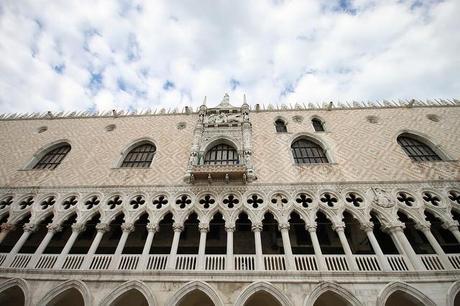
Ok, so first thing first, "What is a Doge?", you ask. A Doge is the Italian version of an English Duke. The Doges were the chief magistrates and were the leaders of the Venetian Republic for over a thousand years. The Doges of Venice were elected for life by the city-state's aristocracy and the following was the tour that Sarah and I took of their residence in the Piazza San Marco.
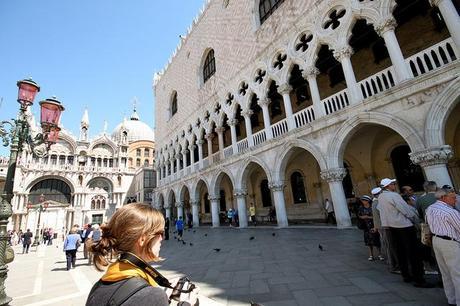
The Palace was first constructed in the 9th century as a fortified castle. It was also the seat of government and the palace of justice. As the town grew, so did the Palace. The intricate double arcades on the 1st and 2nd storey were constructed in the 13th-14th century by Giovanni and Bartolomeo Buon and the 3rd storey was constructed after a fire in the 15th century. The combination of Renaissance and Gothic architecture is what makes this palace so iconic and fascinating. The upper floor has a gorgeous pattern resembling lace-like oriental cresting created on the facade of the building made in white and pink marble. The arcades with their gothic traceries and detailed arches and columns creates a light and airy atmosphere to the base of the building. The use of pale coloured marble on the top makes the top seem lighter, almost as if it was floating atop a beautiful Gothic cloud. There are no better iconic Gothic images than the quatrefoils framed atop ogee arches on the second storey.
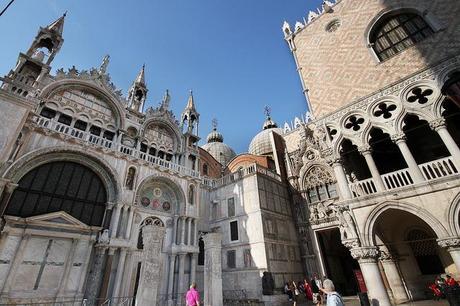
The old entrance that the Doge used to enter from is called the Porta della Carta. This is the middle door you can see in the picture above. The immensely detailed triple lancet window stands above the door. It is a massive stone masterpieces with tiny little detailed traceries making it such an ornamental pieces, clearly detonating its importance. Above the door is the symbol of Venice, which is Saint Mark and the Lion.
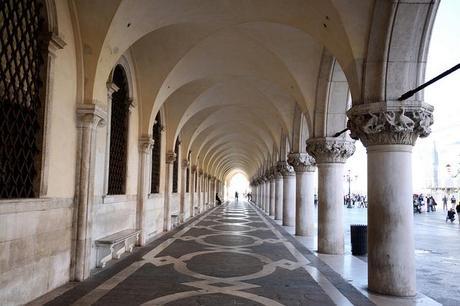
We entered the Doge's Palace first by walking through the 1st floor arcade and underneath the hundreds of beautifully vaulted archways. Each one was supported by an incredibly detailed columns with their own unique capitals.
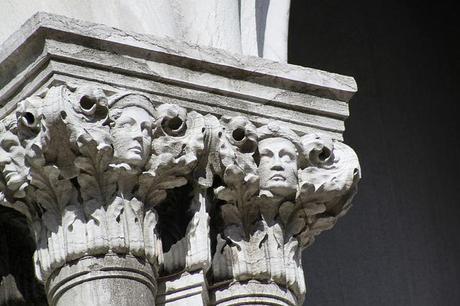
Here is a close up of one of the capitals. Each one has its own meaning. Most of the most famous capitals depict stories from the Bible or from Venetian mythology. They are intricately detailed examples of Gothic architecture of the 13th century and look out over their Venetian public.
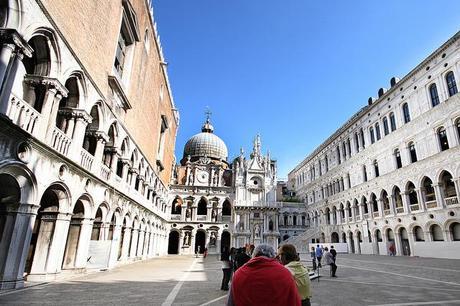
After entering the palace and checking your personal items (your not allowed to bring knapsacks anywhere in Europe...) we are expelled out into the main courtyard. This was an incredible place to be. I could imagine all the busy aristocracy running around this square when it was used in the 15th century. Dukes in dark velvet embroidered suits would leer out of upper storey windows at the incoming visitors. Ladies in waiting would be fetching water from the well and dishing the latest court gossip, their brightly coloured and ornate gowns glittering in the sunlight.

The large white building you can see in the end of this picture is actually the side of the Basilica San Marco. The two buildings were joined so that the Doge had his own private entrance to the Basilica for his daily prayers.
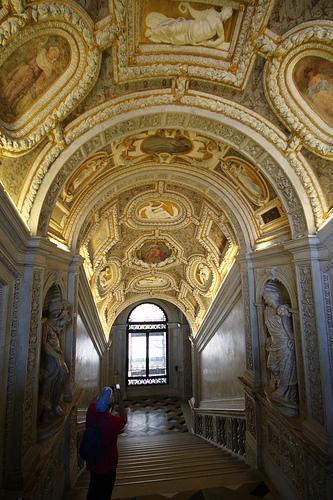
After walking around the courtyard we headed inside the Palace. The decorations inside the palace were much like other from the same period I had seen in other places around the world. Rich, dark velvet curtain, tall ceiling made out of dark wood, embroidered tapestries and hard wood floors that echo the steps of all those walking around inside. You were not allowed photography inside the palace so here are some sourced images of some of the beautiful art inside the palace.
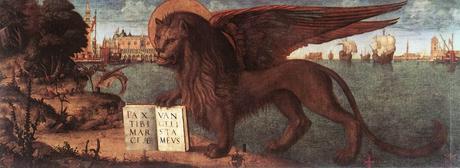 This painting is found inside the Palace and is one of the most interesting pieces from the palace. The painting is by Vittore Carpacci and is called "Lion Passant of Saint Mark". The lion is the symbol for Venice since St. Mark's relics are held in the Basilica and his symbol is a lion. This painting shows the Lion of Venice with one paw in the sea and one on the land, representing Venice's dominion over land and sea. In the background we can see the view of Venice as it was hundreds of years ago. It is wonderful to see how things have remained the same in this city on the sea.
This painting is found inside the Palace and is one of the most interesting pieces from the palace. The painting is by Vittore Carpacci and is called "Lion Passant of Saint Mark". The lion is the symbol for Venice since St. Mark's relics are held in the Basilica and his symbol is a lion. This painting shows the Lion of Venice with one paw in the sea and one on the land, representing Venice's dominion over land and sea. In the background we can see the view of Venice as it was hundreds of years ago. It is wonderful to see how things have remained the same in this city on the sea. 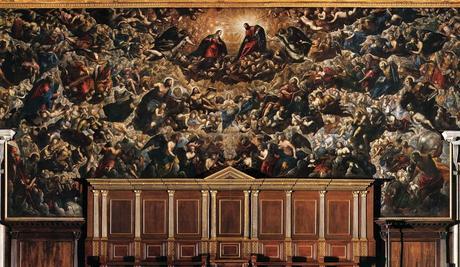
This painting takes up the entire wall in the Great Council Hall. It was painted by Jacopo Tintoretto and the others from his workshop over a three decades and is called "Paradise". It serves as a reminder to the members of the government to conduct their affairs honestly. It was amazing thing to see in real life. Every single saint or angel is as detailed as another. It is a never ending 'Where's Waldo' of saints and you can spend hours looking up at this masterpiece.
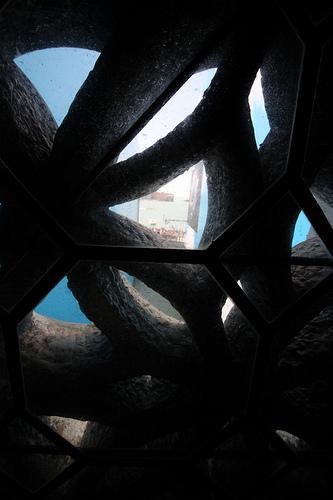
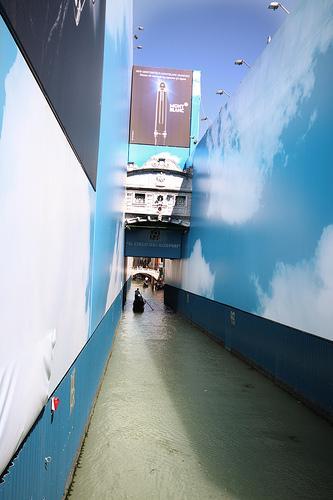
After walking through the galleries and state rooms we headed through the Bridge of Sighs over to the Torture chambers and the prison. The Bridge of Sighs is a very important part of the Palace. This small bridge separates the main residence and judicial apartments from the prison. When prisoners were sentenced to death they were lead through this bridge and into the dungeons. It was through the small windows in the bridge that they were granted one last look out over Venice before being led into the darkness forever. The bridge interior was oddly cold and as we looked out at the blurry vision of Venice you could feel a haunting sadness and anger lingering in the cold stone walls.
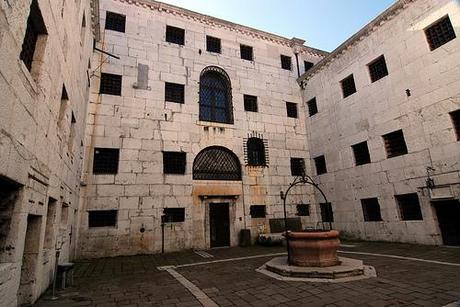 When we went down into the prisons we got slightly lost in all the corridors and at one point it really had seemed like we had walked underneath the city for miles and had somehow gotten out of the "guided" area of the tour and were going to end up in some unknown underground crypt. But fortunately we finally surfaced and saw some other people heading back. We followed them and swiftly made our way back out to the courtyard to grab our bags and head on out.
When we went down into the prisons we got slightly lost in all the corridors and at one point it really had seemed like we had walked underneath the city for miles and had somehow gotten out of the "guided" area of the tour and were going to end up in some unknown underground crypt. But fortunately we finally surfaced and saw some other people heading back. We followed them and swiftly made our way back out to the courtyard to grab our bags and head on out.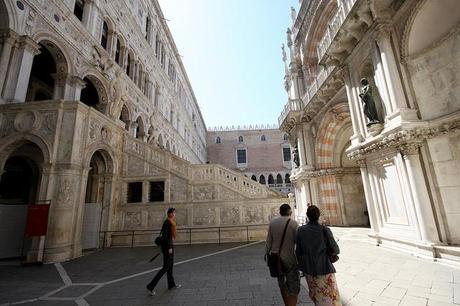
When we left, we walked down the 'Giant's Staircase'. This was a late 15th century staircases designed by Antonio Rizzo and was used for ceremonial purposes. It has some fantastic design featured on either side and we truly did feel like royalty as we walked down the stairs after an entire morning strolling through the immense and luxurious state rooms of the Doge's Palace..
